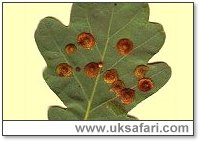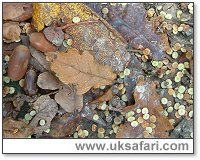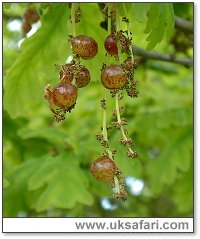
|

|
|
 Sent
to you Sent
to you
by e-mail
|
|
Simply
enter your details and hit the send button
more
info |
|


Click Here

Links
Advertise
Terms of Use
Contributors
About Us
Contact Us
|
 |
Go back
 | Bookmark
| Bookmark
 | Print Page
| Print Page  | E-Mail Us
| E-Mail Us 
 

Photo: G. Bradley |
|
UK
Safari Tip:
To help you identify the most frequently found galls there's a
fully illustrated fold out chart in the Nature Shop - click
here
|
|
Spangle galls are normally seen in late summer or early autumn on the underside of oak leaves. They are caused by the female gall wasp Neuroterus quercusbaccarum.
A single leaf can have up to 100 of these galls, each containing a single developing larvae.

Photo: G. Bradley
In early autumn the ground below some oak trees can be littered with fallen
spangle galls. The larvae continue to develop inside, and in spring the females
emerge to lay their eggs on the oak catkins.

Photo: G. Bradley
These produce 'Currant galls' (shown above), which hang like redcurrants. In
summer the adult sexual generation will emerge and lay their eggs on the
undersides of the oak leaves.

UK Safari Galls Section
UK Safari Plants and Trees Section
UK Safari Creepy-Crawlies Section
|
 |

|